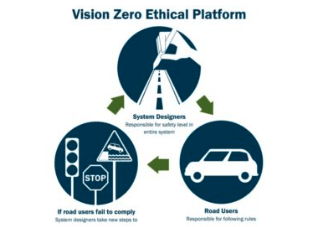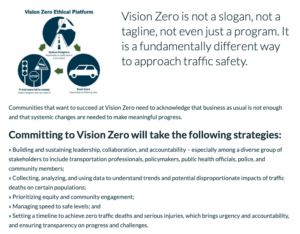All 20 alders have signed on, the plan is moving forward, but is this what we need to reduce crashes – and injuries and deaths? Will it be enough?
BECOMING A VISION ZERO COMMUNITY
Here’s the resolution to be a Vision Zero Community and a commitment to spend half a million to $1M a year on initiatives:
Fiscal Note
The proposed resolution authorizes the City of Madison to become a Vision Zero Community. This resolution commits the City to setting a goal of eliminating traffic fatalities and severe injuries, developing a Vision Zero strategy or plan and committing departments to carry out the strategies. The 2020 Adopted Capital Budget includes $350,000 for a Vision Zero project in Traffic Engineering’s budget. Additional funding will be requested to implement the Vision Zero Plan recommendations. Annual capital budget requests likely would range from $500,000 to $1,000,000 per year for at least 10 years.
Title
Adopting and endorsing a Vision Zero policy to eliminate fatalities and serious injuries that are a result of crashes on streets and paths within the City of Madison by 2030.
Body
WHEREAS, one death on Madison streets is one too many; and,
WHEREAS, crashes that result in death or serious injury are not inevitable but largely preventable and stem in part from human inattention and designs that are ineffective in accommodating multimodal uses in urban environments; and,
WHEREAS, a commitment to Vision Zero is a commitment to life and equitable opportunity for people in the City of Madison; and,
WHEREAS, it is the role of government to do its part to serve and protect the populace; and,
WHEREAS, the City of Madison is recognized and strives to be continually acknowledged nationally and internationally as a healthy, attractive, desirable, and safe City; and,
WHEREAS, people walking and biking are at the highest risk of serious injury and represent 41% of crashes; and,
WHEREAS, Madison has a strong history of commitment to prioritizing safety and recently completed, or will soon complete, crash studies for both bicyclists and pedestrians and has made demonstrable progress to improve safety for walking and biking through systemic changes in the way the transportation network is planned, programmed, designed, constructed, and operated; and,
WHEREAS, pedestrian and bicycle safety shall be a priority for the City of Madison with updated infrastructure and safety improvements to ensure those most vulnerable on the roads are protected; and,
WHEREAS, 14 people walking and in wheelchairs, 4 people riding a bicycle, and 26 people driving or riding in a vehicle have died on streets in Madison between 2014 and 2018; and,
WHEREAS, hundreds of crashes occur in the City each year, resulting in serious injuries and other injuries; and,
WHEREAS, reducing deaths involving a motor vehicle was a great public health achievement of the 20th century, but progress has stalled in recent years and many City residents continue to die from or be seriously injured by preventable crashes; and,
WHEREAS, crashes on City streets necessitate a comprehensive and specific approach to street planning, design, policy, enforcement, legal processes, education and communication in order to provide the best solutions; and,
WHEREAS, both design and policy impact safety and an example is shown through multiple studies that demonstrate the chances of a pedestrian being killed by a car traveling 20 mph is 10% while the chances of being killed when struck by a car traveling 40 mph is 80%; and,
WHEREAS, walking and biking decrease mortality and morbidity from obesity-related diseases such as heart disease and diabetes; and,
WHEREAS, creating safer streets is likely to encourage more active transportation, thereby increasing population health; and,
WHEREAS, the City of Madison is actively working to implement technology advances in automation, connected vehicles and other emerging technologies; and,
WHEREAS, implementing a Vision Zero commitment requires collaboration between the Mayor’s Office, The Common Council, Traffic Engineering Division, Police Department, City Engineering Division, Fleet Services Division, Metro Transit and Public Health of Madison and Dane County, all of which have committed to support and implement Vision Zero; and,
WHEREAS, implementing a Vision Zero commitment requires the continued support of residents, business owners, and visitors to the City of Madison, acting as individuals and collectively through neighborhood or advocacy organizations to improve the safety, comfort, and usability of City streets for all users; and,
WHEREAS, Madison will join other leading cities around the nation and cities around the globe in their commitment to eliminate traffic deaths and serious injuries on our streets; and,
WHEREAS, the work of other Vision Zero cities have demonstrated success when coupled with adequate funding and staffing levels, and that Madison will need to carefully consider the successes and challenges in other cities implementing Vision Zero policies,
NOW, THEREFORE, BE IT RESOLVED, that the Mayor and Common Council of the City of Madison commit to a goal of zero deaths and serious injuries that are a result of crashes on City streets by 2030; and
BE IT FURTHER RESOLVED, that since achieving this goal requires significant effort and resources, staff are directed to develop a Vision Zero Action Plan following the passage of this resolution; and,
BE IT FURTHER RESOLVED, that the Vision Zero Action Plan will put equity at its forefront, striving to impact the most vulnerable and dependent users of the most dangerous parts of the transportation network to improve the health and well-being of those traveling on streets and paths in the City of Madison. And that, the Plan will use data and community outreach to develop strategies that aim to end death and serious injuries on City streets in the effort to ensure outcomes will be experienced equitably throughout the City; and,
BE IT FURTHER RESOLVED, that the Vision Zero Action Plan will draw heavily from those who use our streets, including those who live in areas that experience high crash rates, those who advocate for safer streets for all modes, and the general public, through a diverse range of outreach activities designed to understand both concerns and opportunities with advancing this vision, and by using their input and refined data to determine appropriate and effective steps to achieve in the Vision Zero Action Plan; and,
BE IT FURTHER RESOLVED, that the Vision Zero Action Plan will outline specific steps in planning, engineering, policy, enforcement, and education to reach interim steps toward zero deaths; and,
BE IT FURTHER RESOLVED, that the allocation of Vision Zero funding will use data driven analysis to dedicate investments to the City’s High Injury Network in order to have the greatest reduction in fatalities and severe injuries; and,
BE IT FURTHER RESOLVED, that all City of Madison programs and capital investments will use a safety lens consistent with Vision Zero in their operation and implementation; and,
BE IT FURTHER RESOLVED, that the City of Madison will work with partners in the region who own and manage streets in the City to influence the street planning, design, maintenance, operations, and law enforcement, including the Wisconsin Department of Transportation, The University of Wisconsin, Dane County Highway Department, and neighboring municipalities to combine similar efforts and leverage individual work efforts to contribute to improvements in safety region-wide; and,
BE IT FURTHER RESOLVED, that the City of Madison acknowledges and accepts that the Vision Zero Action Plan may result in changes to the City’s approach to the planning and design of streets, education and communication techniques, enforcement policies and procedures, and legal and legislative frameworks including the potential to advocate for reduced City speed limits,
BE IT FINALLY RESOLVED that the City of Madison is dedicated to measuring the progress, challenges, and successes of the Vision Zero commitment and will do so with tangible, reportable metrics that will be reported upon on an annual basis.
SPECIFIC PLANS
This is the list of things to do this year to reach the above goals:
East Washington Ave Corridor (Pinckney-Baldwin)
Improvement:
- Change Speed limit signs from 35mph to 25mph
- Upgrade all crosswalks to continental crosswalks
- Retiming (7) traffic signals along the corridor to promote reduced speed
Explanation:
- Corridor has changed to a residential/high pedestrian volume street
- High number of pedestrian destinations in corridor
- Reduce crash severity
- Continental crosswalks are more visible and increase yield compliance
East Washington Ave Corridor (Baldwin-Marquette)
Improvement:
- Change Speed limit signs from 35mph to 30mph
- Retiming (6) traffic signals along the corridor to promote reduced speed
Explanation:
- High number of pedestrian destinations in corridor
- Reduce crash severity
East Washington Ave & Livingston St
Improvement:
- Install bollards on median
Explanation:
- Increase safety of pedestrians waiting to cross E Washington
Park Street & Buick St Intersection
Improvement:
- Upgrade to continental crosswalks
Explanation:
- Crossing to The Villager, which includes a library, social service agencies, stores
- Continental crosswalks are more visible and increase yield compliance
Park Street & Badger Rd Intersection
Improvement:
- Upgrade to continental crosswalks
Explanation:
- Crossing to Madison College and other destinations on Badger Rd
- Continental crosswalks are more visible and increase yield compliance
Gammon Rd Corridor from Watts to Colony
Improvement:
- Reduce speed limit from 35 mph to 30 mph
- Retiming (9) traffic signals along the corridor to promote reduced speed
Explanation:
- Heavy motor vehicle & traffic & pedestrian volume due to shopping areas
- Lowering the speed limit to 30mph increases safety and matches the land use
Milwaukee St from Stoughton Rd to Thompson
Improvement:
- Reduce speed limit from 35 mph to 30 mph
Explanation:
-
Slow speeds in residential area to match land use
Highland Ave & University Ave
Improvement:
- Install continental crosswalks
- Install protected Left Turn with new controller
- Implement lead pedestrian intervals (done)
- Automatic pedestrian recalls (done)
- Improved pedestrian signing (done)
Explanation:
-
High pedestrian & bike volume on University Ave & Highland Ave
-
Continental crosswalks are more visible and increase yield compliance
-
The protected left turn will create a specific time interval for the turn movement increasing safety for drivers, pedestrians and bicyclists
-
Lead pedestrian intervals, automatic pedestrian recalls and pedestrian signing improve pedestrian safety and accommodation
Prairie Rd from Raymond Rd to Maple Grove Rd
Improvement:
- Reduce speed limit from 30mph to 25mph
Explanation:
- Slow speeds in residential area to match land use
Mobile Speed Trailers
Improvement:
-
2 Radar Speed Trailers
Explanation:
- Educate drivers on new speed limits
- Reinforce speed limits
- Use during speed education/enforcement campaigns
Crash Analysis Equipment
Improvement:
- Crash Data Recorder (CDR)
Explanation:
- CDR allows collection of vehicular pre-crash data for more effective crash analysis
WHATDAYA THINK?
Are these the areas you would have chosen?
Do you think these actions will have the desired effects?
What more should be done?
I think they probably failed on this one on the prioritizing community engagement, and most likely equity.
Your chance to speak up is on Wednesday
5:00 pm Transportation Commission VIRTUAL This meeting is being held virtually.
1. Written Comments: You can send comments on agenda items to pmcguigan@cityofmadison.com
2. Register but Do Not Speak: You can register your support or opposition to an agenda item at https://www.cityofmadison.com/MeetingRegistration.
3. Register to Speak or to Answer Questions: If you wish to speak at the virtual meeting on an agenda item, you must register. You can register at https://www.cityofmadison.com/MeetingRegistration. When you register to speak, you will be sent an email with the information you will need to join the virtual meeting.
4. Watch the Meeting: You can call-in or watch the Transportation Commission meeting in several ways:
• Livestream on the Madison City Channel website https://media.cityofmadison.com/mediasite/showcase
• Livestream on the City of Madison YouTube channel https://www.youtube.com/user/CityofMadison
• Television: Watch live on Spectrum channel 994 and AT&T U-Verse channel 99
• Listen to audio via phone: (877) 853-5257 (Toll Free) Webinar ID: 972-1640-6101





